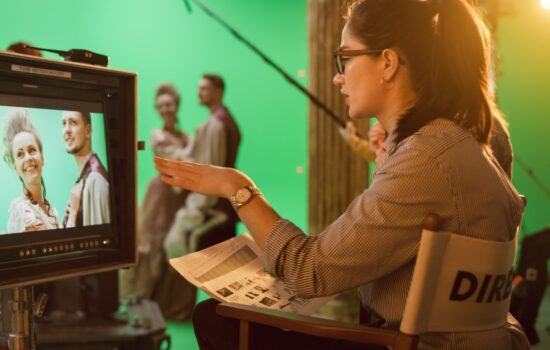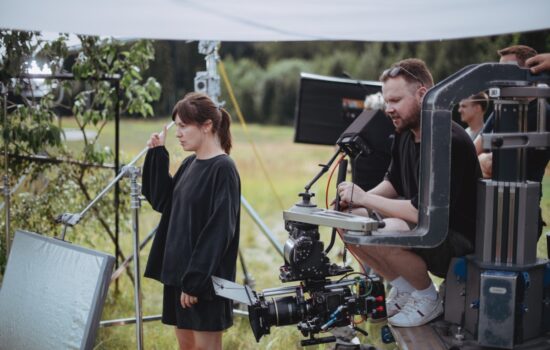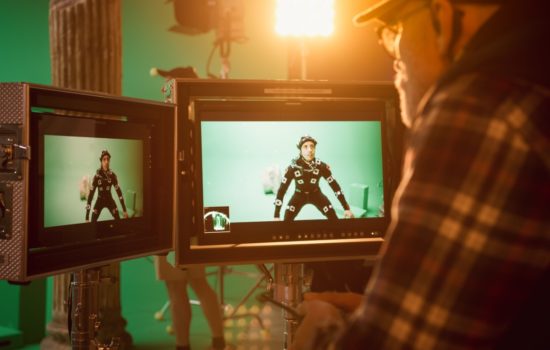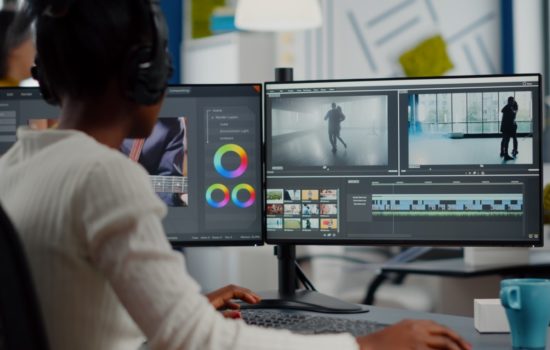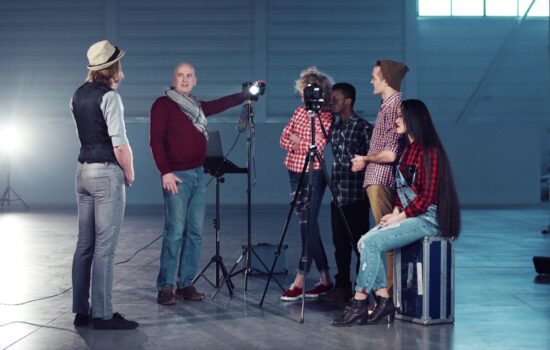Graphic Artist
Career Overview
Graphic Artists implement general visual effects and create custom transitions through carefully selected fonts and colors.
Alternate Titles
Motion Graphics Artist, Motion Graphics and Titles
Avg. Salary
$80,000
Salary Range
Up to $120K

How To Become a Graphic Artist
People also ask
Career Description
A Graphic Artist adds logos and text and manipulates images for a project. They can also create custom transitions between shots. It’s akin to visual effects work and many people cross over.
David Kitchner, who has worked on various commercials, music videos, and logos, describes the process:
“I start a new project and talk with the client to figure out the general aesthetic. Once the overall feeling and look are established, then pre-production begins. Pre-production is essentially organizing assets and creating a stylebook or style guide for final approval — basically, going through colors and fonts to get inspiration and try something new.”
Within this aspect of design, the Graphic Artist is helping to tell the story by giving first impressions so it’s crucial that there is intention behind every decision. Following a Graphic Artist’s conceptualizations receiving approval, the assets will be manipulated in a program like Cinema 4D or Adobe After Effects.
From there, the Graphic Artist goes through rounds of notes. Once the project is complete, they deliver the final product to the client.
What does a Graphic Artist do?
Graphic Artists can work in any number of fields, and their jobs may vary based on the industry in which they’re interested. In film, Graphic Artists are hired to create visual effects and cinematic transitions. For this reason, they may be referred to as Motion Graphic Artists.
Salary
For a Graphic Artist in the film industry, Kitchner says, “Average pay is $80,000 per year but can go upward of $120,000.”
A Graphic Artist is a freelance position, and their pay can vary greatly. Kitchner says, “It can really depend. Sometimes the rate is per project and other times a company will hire an individual to work on multiple things at a day rate. If a Graphic Artist is on staff, then they’ll be paid every Friday. If it’s a freelance job, then it’s usually half before and half after.
“The way most work is bid on is by the second; for example, one second will cost $2,000 or $20,000. Currently, I make at least $500 per day. That is without any rush fees or holding rates.”
The career of a Graphic Artist can be a lucrative one, but it is likewise a highly competitive profession where individuals may be asked to provide bids for a particular gig. It’s important to develop a reel that demonstrates the skill level that a Graphic Artist has to justify the asking rate for their work.
Hey, what do you think about trying our new Film Career HelperFilm Career Helper really quick? It’s totally free and could help get your career moving fast! Give it a try. It’s totally free and you have nothing to lose.
Career Outlook
Graphic Artists most typically work as freelancers. Kitchner comments, “Starting out in the industry, people work late nights. They’ll have weird, long hours, sometimes as long as twelve-hour days. With every project, there is a learning curve, a new way of doing it. Extra time needs to be put in and it can’t be put on the client. Can’t bill that!
Once someone becomes more accomplished they can control their own hours and work a bit less. People can work five hours on, then six hours off before going back. Usually, it still tends to be a ten-hour day but there is more flexibility to goof off and switch between projects.”
As someone can learn more and develop a client base they’ll be able to have more flexibility in their schedule and work fewer hours overall. While there will still be a learning curve on every project, it’ll be less. However, since it is a freelance job, some hours will be spent on weekends and evenings as well as during the day — especially if there is a tight deadline to be met.
The Graphic Artist is usually working with the Post Supervisor or VFX Supervisor. They also collaborate with Editors and work with Assistant Editors to get assets. They typically work alongside the Colorist as well.
Is a Graphic Artist the same as a Graphic Designer?
Graphic Artist and Graphic Designer are titles that might be used interchangeably; however, they constitute two distinct jobs. A Graphic Artist conceptualizes computer imagery, and with approval of those conceptualizations, generates the needed images and transitions for a film or other form of entertainment. A Graphic Designer tends to work with imagery and text for the specific purpose of selling an idea or marketing it.
Career Path
Advancement as a Graphic Artist depends partially on the knowledge a person acquires of software programs used by those in the field.
Kitchner says, “People don’t need to go to school but it helps. I started by learning on the job, taking on bigger projects, researching tutorials, and learning one job at a time. When a candidate is applying to a company, if they’re able to do basic stuff then they can come in as a Post-Production Assistant.
“Even though they can do basic work, much of their day is spent getting coffee and shuttling hard drives around town. They will also clean up computers so there isn’t too much digital bulk and [they will] organize assets.”
As a person develops their skills and builds trust within the company, they’ll be promoted to a Graphic Assistant. They’ll then handle cleaning up project files and doing exports. The next step up is working as a Graphic Artist. People can speed up their advancement by learning multiple programs and practicing with online tutorials. This is a career where what a person knows—and having the ability to demonstrate it—counts.
It can be tough to break into getting even an entry-level job as a Graphic Artist. Kitchner advises, “Do as many internships as possible at the best places possible. Another way is to go on Reddit and look up the demo reels of working professionals. Give them a call or an email. It may take twenty calls to get one person to answer.
“Knowledge is power. Nobody cares what school someone came out of. If a person is good, then people will hire them. Also, it’s important to live in Los Angeles, New York, or Vancouver. It’s where most of the post-production houses are. I take my daughter to the swings on the playground and have gotten jobs. Everyone works in the industry, so networking and random connections are easier.”
When asked about getting started if living outside the major industry hubs, Kitchner suggests, “Start at a small company and learn by shadowing. It could be at the local television network as it’s in the entertainment industry. From there, move out to Los Angeles and start getting jobs wherever they’re available. Working is a good way to meet people.
While the production side of filmmaking is becoming global, the post-production companies are still based in big cities.”
Aspiring Graphic Artists should strongly consider moving to a large city like Los Angeles or New York because that is where the majority of post-production work happens. There will be more opportunities and chances to advance as well as network with professionals to learn.
The following offers additional tips for those just entering this field:
- Get to know one specific program. High-quality footage can be downloaded and there are many tutorials to try out. The best way to learn it is to do it.
- Join Lynda.com for tutorials.
- Call up a production company in town and express interest in learning from them.
- Watch the opening credits sequences of movies.
- Pay attention to the motion graphics in commercials.
Experience & Skills
A good background in design is great for becoming a Graphic Artist. Kitchner says, “People don’t need to be great animators. If they have that talent then it’s a great pull. But diversifying interests can also enrich an aspiring Graphic Artist.
“Learn sculpting. Learn ceramics. Learn typography. Learn drawing. And really learn color theory. It all plays in and is valuable for building a network that will yield referrals. Most jobs come through a ‘who you know’ web.
“Therefore, it’s learning various art forms to develop a distinctive viewpoint and creating a demo reel of work to display what has been learned. If someone can show that they are able to make a desired effect then they’ll get an interview, even if they haven’t worked on big projects.”
People can gain experience through doing online tutorials and creating their own demo reel but they also need to diversify their artistic skills to cultivate a unique viewpoint. While copying is good for learning, Producers want to hire artists who will bring a unique perspective and make their project original.
There are a lot of different personalities conducive to becoming a Graphic Artist, especially those that might not work in a traditional workplace. Kitchner says, “I’m dyslexic and have ADHD. This career is the best thing for it. Most of the people in editing or the design world have something like dyslexia.
“Here it’s a gift because we tell stories without words. Our minds can express without hindrance. Words and texts are a recent thing. For hundreds of thousands of years, humanity communicated through body language, grunts, and gurgles. Maybe some drawings in the sand, too.
“Beyond that, people considering this career field must like to be alone. If they’re a social bird, it can be a hindrance because most of the career is a person locking themselves in a room with only a computer as company. A lot of people would be sad in that scenario.
“However, I’m content sitting with my characters and design. People considering this type of career track need to ask themselves what kind of person they are.”
Individuals who learn in a non-traditional manner can have advantages in the design world. Also, if they are comfortable with long periods of solitude, the career of a Graphic Artist might just be a perfect fit for them.
Is Graphic Artist a good career?
Given that even the most modest films can require visual effects, the demand for proficient Graphic Artists is high. That being said, many Graphic Artists can work long and tedious hours to complete a single shot or frame of footage, often on a high-pressure timetable. For this reason, Graphic Artists must be prepared for a career with periods of dormancy as they wait for a job that will then alternate with periods of intense workloads and quick turnarounds.
Education & Training
The best training or education a person can get to become a Graphic Artist is to attend a specialized school like the Gnomon School.
Kitchner states, “Going to school for Motion Graphics is best. If someone is past that stage in their life they can still succeed without a degree but they need to dedicate themselves to learning the programs and the art form itself. Great undergraduate degrees outside of the motion graphics field are History, Design or getting a general Liberal Arts degree.
“If a person can only push buttons and not know how to think and understand philosophy, then they won’t last long. Graphic Artists are in the storytelling business.”
Many people get caught up in technology, which is important, but what people must get from their education is an understanding of how storytelling interfaces with motion graphics. That way a Graphic Artist can become a collaborator, not just a cog in the machine.
Additional Resources
Since the job of a Graphic Artist has a strong element of solitude grounded in computer work, many online resources and organizations are available to access from home. Some can be found just by using Google.
Kitchner mentions, “The Visual Effects Society (VEF) is great to follow. Lynda.com is a solid tutorial website that can even be accessed for free, depending where a person lives and if they have a library card. In terms of groups, if a person lives in Los Angeles they can see the professionals from organizations such as NAB and SMPTE speak and have meetings.”
Becoming part of the graphics community involves figuring out when events are being held and attending them. Also, check out non-profit organizations such as Film Independent or the Independent Filmmakers Project. While they don’t necessarily focus on motion graphics, they’re good places to network with filmmakers.
FAQ
What is the single biggest suggestion you would give to someone wanting to get into this career?
“Internships are very important. It can’t be stressed enough. Learning without having a purpose can be tough and they give a direction while building relationships within the field. Even doing a non-traditional internship that doesn’t give any credit or pay can be good because a person will see the process from start to finish.
“Also, going on Craigslist.com to get work, even if it’s just a $50 job is good. Doing low pay and low-risk work like that can almost be an internship within itself. Deadlines will be created and it’ll be important for a person to get the work done.
“Otherwise, it can be tough to do all the nitty-gritty steps required to complete a project. The more a person works, especially in the beginning, the better chance of success and developing a career they have.”
What’s the #1 mistake people make when trying to get into this career?
“The biggest mistake people have is taking another job and pursuing their career as a Graphic Artist as a side project. They should do whatever they can to break into the post-production world or even get on set in the film industry. Even if the job is in production, it’s still keeping them in the same genre of what they want to do. They’ll learn by seeing how the assets are created or implemented.
“Also, it never hurts to learn other aspects of the film industry. Working as a PA on set, a person will learn ten times as much as slinging coffee. It also adds an extra motivation. Watching the best can be inspirational.
“Finally, as a piece of side note advice, don’t worry about failing. Fail a lot. It is the best teacher and it mitigates fear. Nobody has a perfect track record and if someone is failing, it also proves that they are taking steps in the right direction instead of just pursuing their passion when it fits into their ‘other’ life.”
What is the question people should ask about this career but rarely do?
“Do people consider a Graphic Artist a filmmaker?
“Many people don’t consider a Graphic Artist as a filmmaker. They assume that they’re just a cog in the wheel. Some Graphic Artists even think this about themselves. They get hung up on the latest gear or the newest plug-in. The result is that a collaborative opportunity is missed.
“Each part of the overall aesthetic needs to serve the story. That includes any text fonts, graphics or custom cuts. Each Graphic Artist needs to remember that they are serving the story. Then if a client doesn’t realize it, the Graphic Artist can take it upon themselves to incorporate the vibe of the story into their choices and show that to the client. This will form a stronger bond and give repeat work.
“It’s still important to do what the client wants but pushing the conversation over aesthetics further and sharing alternatives that may not have been originally considered will only elevate the Graphic Artist in the client’s eyes.”
What is one thing I should have asked which I didn’t?
“Why is it important to have multiple interests?
“Steve Jobs once walked into a class about fonts and learned about the different ways of typing. It’s what inspired him to have different fonts on the Apple computers. It’s important for a person to get out of their element because they might discover something new. Also, it gives their brain a moment to rest from just focusing on one subject all the time.”
If you could describe in one word what makes you successful, what would it be?
“Perseverance.”
Sources

David Kitchner
David Kitchner is a Motion Graphics and Visual Effects Generalist based in Los Angeles, California. He has worked for LA Care, Anthem Blue Cross Blue Shield, ThredUP, Ignite Visibility, and MGA Entertainment. He is currently employed by Genius Produced.





